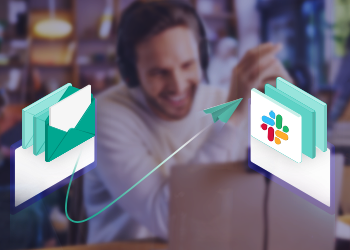
March 20, 2024
Workplace collaboration used to consist of primarily in-person interactions. Nowadays, taking a digital-first approach and using the different tools at our disposal to get the job done is the norm.
The shift to digital-first began with email, a form of communication that revolutionized how we share information by enabling instant, global communication. However, the limitations of email, such as siloed conversations and information overload, soon became clear.
As the need for more dynamic, real-time collaboration grew, instant messaging and chat apps emerged which marked a significant turning point in workplace collaboration. These platforms and apps paved the way for more connected, efficient, and flexible working environments, but came with their challenges.
Today, integrated platforms that combine messaging, video conferencing, and project management are commonplace, however, many workers and businesses still use multiple business apps to collaborate.
Reliance on Email for Communication
Email was once the cornerstone of digital workplace communication. But despite its widespread adoption, email’s limitations in fostering effective collaboration became apparent. The linear, conversation-based nature of email often led to siloed interactions, where information could easily become compartmentalized and difficult to share across teams.
Additionally, the sheer volume of messages contributed to information overload, making it challenging to prioritize and manage tasks efficiently. These challenges highlighted the need for more agile and collaborative communication tools, setting the stage for the next wave of innovation in workplace collaboration.
Emergence of Instant Messaging and Chat Apps
Instant messaging (IM) was a game-changer for workplace communication. Early chat programs such as AIM (AOL Instant Messenger) and MSN (Microsoft Network), offered a quicker, more informal way to communicate, breaking down the barriers of formal email structures.
The impact of chat apps and the shift towards more instant and less formal communication was profound. It laid the groundwork for integrated and versatile collaboration solutions that could keep pace with the interconnected nature of modern work.
The Arrival of Integrated Platforms
The development of integrated platforms that revolutionized how teams work together was another major turning point in workplace collaboration. Tools like Slack, Microsoft Teams, and Asana arrived, merging messaging, video conferencing, and project management into cohesive ecosystems.
Task and project management tool, Asana, was launched in 2012, while Slack (which is an acronym for “Searchable Log of All Conversation and Knowledge) was initially released in 2013, and Microsoft Teams was launched as a direct competitor to Slack in 2017.
These platforms addressed the fragmentation of previous tools, offering a unified space for all aspects of collaboration. The benefits were immediate: reduced context switching, centralized communication, and streamlined workflows.
Integrating various functionalities also fostered better team alignment. The ease of accessing multiple features in a single environment transformed collaboration efforts, making it easier for teams to stay connected, share ideas, and drive projects forward.
The Future of Workplace Collaboration: Conclude’s Role
So what’s ahead? From Conclude’s perspective, it’s about unifying platforms and programs to reduce information silos and improve collaboration. This is equally true for global or distributed teams and within organizations that may be using both Slack and Teams.
In a recent conversation with CTO, Lars Knoll, he discussed the cognitive cost that modern knowledge workers face when switching between tools. It’s clear that taming the chat program chaos has become a challenge for many modern workers, and as email becomes less relevant (although still required).
Conclude offers a range of features from AI Integrations that summarize emails and open tickets inside Slack, along with Workflows that support conversational ticketing and offer additional types of structure. Link is the solution that connects Microsoft Teams and Slack for bi-directional chat and collaboration, with Jira and Zendesk integrations also available.
The vision to become a platform where companies can also collaborate with external partners and customers and be part of a company’s workflow for the duration of the project is something that Conclude is now realizing. Stay tuned for more updates on upcoming external collaboration features.
Looking further ahead, collaboration platforms are likely to evolve and become more personalized with the application of Artificial Intelligence which detects users’ work habits and preferences to create a customized experience. This could be something like a dynamic user interface that adapts to the task at hand, or a smart notification system that prioritizes alerts based on a user’s current focus. Only time will tell.
Get started with Conclude, free for 30 days here.


